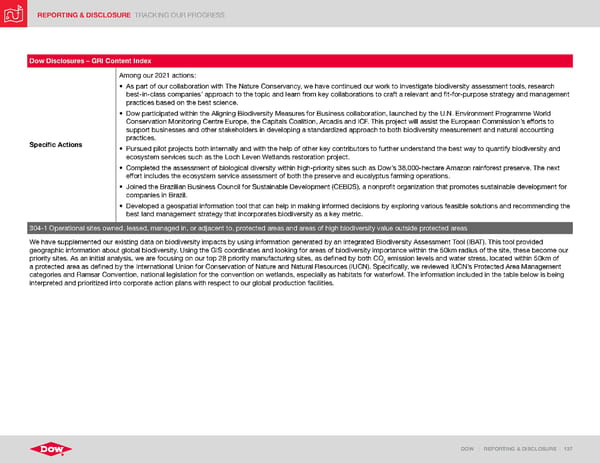REPORTING & DISCLOSURE TRACKING OUR PROGRESS DOW | REPORTING & DISCLOSURE | 137 Dow Disclosures – GRI Content Index Specific Actions Among our 2021 actions: • As part of our collaboration with The Nature Conservancy, we have continued our work to investigate biodiversity assessment tools, research best-in-class companies’ approach to the topic and learn from key collaborations to craft a relevant and fit-for-purpose strategy and management practices based on the best science. • Dow participated within the Aligning Biodiversity Measures for Business collaboration, launched by the U.N. Environment Programme World Conservation Monitoring Centre Europe, the Capitals Coalition, Arcadis and ICF. This project will assist the European Commission’s efforts to support businesses and other stakeholders in developing a standardized approach to both biodiversity measurement and natural accounting practices. • Pursued pilot projects both internally and with the help of other key contributors to further understand the best way to quantify biodiversity and ecosystem services such as the Loch Leven Wetlands restoration project. • Completed the assessment of biological diversity within high-priority sites such as Dow’s 38,000-hectare Amazon rainforest preserve. The next effort includes the ecosystem service assessment of both the preserve and eucalyptus farming operations. • Joined the Brazilian Business Council for Sustainable Development (CEBDS), a nonprofit organization that promotes sustainable development for companies in Brazil. • Developed a geospatial information tool that can help in making informed decisions by exploring various feasible solutions and recommending the best land management strategy that incorporates biodiversity as a key metric. 304-1 Operational sites owned, leased, managed in, or adjacent to, protected areas and areas of high biodiversity value outside protected areas We have supplemented our existing data on biodiversity impacts by using information generated by an Integrated Biodiversity Assessment Tool (IBAT). This tool provided geographic information about global biodiversity. Using the GIS coordinates and looking for areas of biodiversity importance within the 50km radius of the site, these become our priority sites. As an initial analysis, we are focusing on our top 28 priority manufacturing sites, as defined by both CO 2 emission levels and water stress, located within 50km of a protected area as defined by the International Union for Conservation of Nature and Natural Resources (IUCN). Specifically, we reviewed IUCN’s Protected Area Management categories and Ramsar Convention, national legislation for the convention on wetlands, especially as habitats for waterfowl. The information included in the table below is being interpreted and prioritized into corporate action plans with respect to our global production facilities.
 ESG Report | Dow Page 136 Page 138
ESG Report | Dow Page 136 Page 138